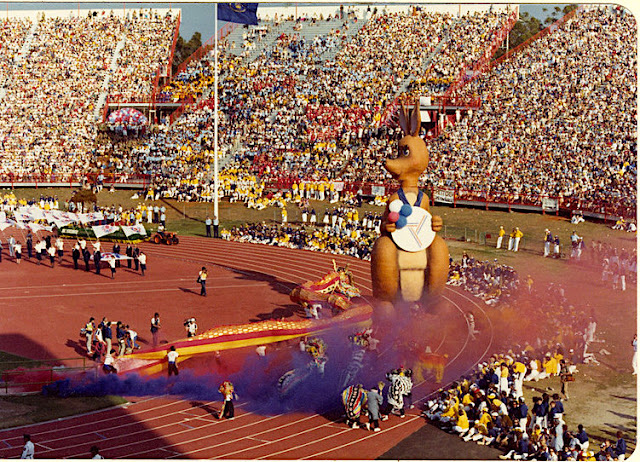The Cooktown area is part of the traditional lands of the Guugu Yimithirr people. An area they called Gungardie, because of the many quartz stones (gun-gaar), that were collected for use in ceremonies.
The Guugu Yimithirr language was one of the earliest Aboriginal languages to be written down. Sydney Parkinson, the botanical draughtsman on James Cook's first voyage, recorded 200 Guugu Yimithirr words during the time that the HMS Endeavour was being repaired at Cooktown in 1770.
 |
| Group from the Cooktown District, ca. 1899, The language Guugu Yimithirr (also known as Koko Yindjir, Gugu Yimidhirr, Guguyimidjir) of this region call this district Gangaar. It divides into thirty-two clan (or extended family) groups. State Library of Queensland |
Aboriginal tradition had strict rules surrounding marriage. At birth, Guugu Yimithirr were given a skin group determined by the skin groups of the parents. This determined who an individual could marry. All marriages would take place between members of opposite moieties.
Marriages were often arranged by infant betrothal (before birth) and the marriage would be between a young girl and an older man.
According to Willie Gordon, Guurrbi: My Family and Other Stories, Guurrbi Tours, 2012 (see here) It was a tradition in earlier times that the mother-in-law would strike the man marrying her daughter, with a sharp stick during the wedding ceremony. This was to ensure that the groom had no attraction to his mother-in-law, as they were often of a similar age.
If a man was unavoidably in his mother-in-law's presence, he would sit silently (guugu-mul), with head bowed.
 |
| Group from the Cooktown District, ca 1899, This photographs depicts a group of men, women and children of this region. Some of the men have cicatrices, headband, fibre belts and spears. The woman holding the baby with the shell pendant necklace has cicatrices [scarring] on her upper left shoulder and another is wearing a hair loin cloth. State Library of Queensland |
The Aboriginal Protector Dr Walter E. Roth, who was appointed in 1898 and was based in Cooktown, made many reports about Aboriginal people, throughout North Queensland, including about the avoidance language (taboos). He recorded that certain relatives were strictly taboo and must not be approached, conversed with, accept anything from, nor give them anything. This especially refers to the father-in-law and mother-in-law. It is the usual practice for a man never to talk to his blood-sister, or sometimes, not even mention her name after she has reached womanhood.
Dr Roth also wrote that the presence of disease was believed to be the result of "sorcery and witchcraft and the hands of an enemy, by non-observance of certain rules of conduct, by the breaking of taboo". He also mentioned that medicine men would cure disease.
 |
| Kurdaitcha, death is willed by the kurdaitcha man, or bone-pointing, a kangaroo a bone, Sydney Mail (NSW : 1912 - 1938), Wednesday 29 May 1935 |
One traditional story is about how Aboriginal people came to speak different languages: The clans were gathered together for a corroboree (Ngurrayin), near a lagoon at Cooktown, when a giant groper (nhinhini), leapt of the lagoon and swallowed many of the people. With the people in his belly, the groper swan out into the ocean. Returning months later, the groper spat out the people, who began talking in different languages.
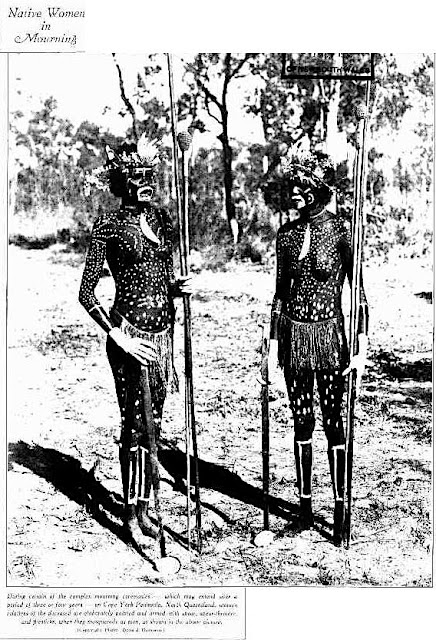 |
| During certain of the complex mourning ceremonies — which may extend over a period of three or four years — on Cape York Peninsula, North Queensland, womentrelatives of the deceased are elaborately painted and armed with spear, spear-thrower, and firesticks, when they masquerade as men, as shown in the above picture. Sydney Mail (NSW : 1912 - 1938), Wednesday 1 November 1933 |
Cook's Landing
Lieutenant James Cook left England in 1768, on a mission for the Royal Society. He sailed the HMS Endeavour to the islands of Tahiti, to record and observe the movement of the planet Venus, as its shadow crossed the Sun.
 |
| HMS Endeavour. On 26 August 1768, Captain James Cook departed from Plymouth on the HMS Endeavour. With him were 94 men, copious supplies, and secret instructions to locate the fabled southern continent known as ‘terra australis incognita’. They did not find the unknown continent, but they did arrive in Aotearoa New Zealand. His name, and that of the ship, has dominated the story of European exploration of Aotearoa New Zealand ever since. Archives New Zealand |
On the 20th April 1770, Cook saw the east coast of Australia at Port Hicks. Then on 23rd April, he sees Aboriginal Australians at Ulladulla. Cook anchors at Botany Bay on 29th April and encounters the Gweagal people. The Endeavour sails north. (The Endeavour landed fourteen times on the East Australian Coastline).
The Endeavour managed to stay afloat for another week, eventually sighting land. The ship was landed on 10 June 1770. It takes seven weeks to repair the ship at the mouth of the Endeavour River (Waalumbaal Birri). The Guugu Yimithirr name for the area is "Charco".
 |
| British Library digitised image from page 15 of "Captain Cook's Original Voyages round the World [The abridgment of G. W. Anderson.] Embellished with engravings, etc" British Library |
 |
| Postcard depicting Captain Cook's ship 'Endeavour' having repairs done to it in what is now named Cooktown, during his exploration of the Australian continent in 1770. Cooktown, Queensland - circa 1910, Kaye |
After twice setting fire to Cook’s camp and killing a suckling pig, the Aboriginal people were chased away.
Read Cook's Journal
10 July 1770
"....the Natives came down to the Sandy point on the North side of the Harbour, having along with them a small wooden Canoe with Outriggers, in which they seem’d to be employed striking fish, etc … Some part of their Bodys had been painted with red, and one of them had his upper lip and breast painted with Streakes of white … we met with 5 of the Natives, and although we had not seen any of them before, they came to us without showing any signs of fear. 2 of these wore Necklaces made of Shells, which they seem’d to Value, as they would not part with them".
19 July, 1770, James Cook wrote:
“In the AM we were viseted by 10 or 11 of the natives, the most of them came from the other side of the River where we saw six or seven more the most of them women and like the men quite naked; those that came on board were very desirous of having some of our turtle and took the liberty to haul two to the gang way to put over the side, being disapointed in this they grew a little troublesome, and were for throwing every thing overboard they could lay their hands upon; as we had no victuals dress'd at this time I offer'd them some bread to eat, which they rejected with scorn as I believe they would have done any thing else excepting turtle. Soon after this they all went a shore, Mr Banks my self and five or six more of our people being a shore at the same time; emmidiatly upon their landing one of them took a handfull of dry grass and lighted it at a fire we had a shore and before we well know'd what he was going about he made a large circuit round about us and set fire to the grass on the ground in his way and in an Instant the whole place was in flames, luckily at this time we had hardly any thing ashore besides the forge and a sow with a Litter of young pigs one of which was scorched to death in the fire. As soon as they had done this they all went to a place where some of our people were washing and where all our nets and a good deal of linnen were laid out to dry, here with the greatest obstinacy they again set fire to the grass which I and some others who were present could not prevent, untill I was obliged to fire a musquet load[ed] with small shott at one of the ri[n]g leaders which sent them off. As we were apprised of this last attempt of theirs we got the fire out before it got head, but the first spread like wild fire in the woods and grass. Notwithstanding my fireing, in which one must have been a little hurt because we saw a few drops of blood on some of the linnen he had gone over, they did not go far from us for we soon after heard their voices in the woods; upon which Mr Banks and I and 3 or 4 More went to look for them and very soon met them comeing toward us. As they had each 4 or 5 darts a piece and not knowing their intention we seized upon six or seven of the first darts we met with, this alarmed them so much that they all made off and we followd them for near half a Mile and than set down and call'd to them and they stop'd also; after some little unintelligible conversation had pass'd between us they lay down their darts and came to us in a very friendly manner; we now return'd the darts we had taken from them which reconciled every thing. There were 4 strangers among them that we had not seen before and these were interduce'd to us by name by the others: the man which we suppos'd to have been struck with small shott was gone off, but he could not be much hurt as he was at a great distance when I fired. They all came along with us abreast of the ship where they stay'd a short time and then went away, and soon after set the woods on fire about a Mile and a half or two miles from us... In the PM got every thing on board the Ship, new birth'd her and let her swing with the tide. In the night the Master return'd with the Pinnace and reported that there was no safe passage for the Ship to the northward”. Read here and here
Monday 23 July: From Cook's journal
"I sent some people in the Country to gather greens, one of which stragled from the rest, and met with 4 of the Natives by a fire, on which they were broiling a Fowl, and the hind leg of one of the Animals before spoke of. He had the presence of mind not to run from them (being unarm'd), least they should pursue him, but went and set down by them; and after he had set a little while, and they had felt his hands and other parts of his body, they suffer'd him to go away without offering the least insult, and perceiving that he did not go right for the Ship they directed him which way to go."
 |
| Engraving by T. Chambers 1773 based on a drawing by Sydney Parkinson NLA |
Cook also reported seeing a strange animal on Sunday 24 June 1770:
Guugu Yimithirr First Written Down
Joseph Banks was greatly excited by the many botanical and zoological discoveries made in the area.
24 June 1770: Recorded by James cook:
"I saw my self this morning a little way from the ship one of the Animals before spoke off, it was of a light Mouse colour and the full size of a grey hound and shaped in every respect like one, with a long tail which it carried like a grey hound, in short I should have taken it for a wild dog, but for its walking or runing in which it jump'd like a Hare or a dear. Another of them was seen to day by some of our people who saw the first, they describe them as having very small legs and the print of the foot like that of a goat, but this I could not see my self because the ground the one I saw was upon was too hard and the length of the grass hinderd my seeing its legs..."
Sir Joseph Banks wrote in his journal that the natives called the animal a "Kangooroo" (ganguuru).
Sir Joseph Banks wrote in his journal that the natives called the animal a "Kangooroo" (ganguuru).
Survey 1819
River. Allan Cunningham, who was the King’s Botanist, sent out from Kew, climbed and named Mount Cook, August 2, 1819.
L King wrote:
 |
| Image from page 26 of "The naturalist in Australia" (1897) |
Any Mineral Resource?
William Hann (of Maryvale Station on the Burdekin River) was commissioned by the Queensland Government 1872 to "ascertain as far north as the 14th parallel of latitude, the character of the country and its mineral resources, with a view to future settlement and occupation". On this journey, accompanied by Aboriginal stockman Kulajerry.
Hann found gold in the Palmer River, which he named after Queensland’s Colonial Secretary and later, Premier, Arthur Palmer. Though his gold reports were not encouraging, this did not stop hopeful prospectors setting out to try their luck. In October 1873, a Queensland government party, along with about 93 miners, arrived at the Endeavour River to make a track to the Palmer River and to proclaim the goldfields.
The group was led by Northern Roads Engineer A Macmillan, Gold Commissioner H St George and the Native Mounted Police Force. Writing in the Sydney Morning Herald in 1874, Charles Heydon exclaimed, "Can it be possible that its leaders had received no instructions as to their treatment of the natives, and the importance of establishing friendly relations and treating them with kindness?"
 |
| Police Riot Squad and Native Mounted Police, c1890's, Queensland State Archives |
The Rush is On
James Venture Mulligan and companions brought back 102 ounces of payable alluvial gold from the Palmer River in 1873, which triggered one of Australia's last gold rushes.
The Endeavour River was soon full of steamships carrying hopeful diggers from all over Australia, New Zealand, the British Isles, China and the world. The port and town of Cooktown came into existence.
Cooktown was declared a municipality on 5 April 1876.
The Cooktown to Laura railway was built in 1884-88, and many roadworks were instigated to enable access roads between the Palmer River goldfields, the Annan River tin mines and the wharves at Cooktown.
The first Cook District Hospital, a small timber structure situated on the ridge above Charlotte Street (between Banks and Green Streets), was erected in April 1874.
 |
| Charlotte Street, Cooktown, 1878, QLD |
The Wild Frontier
By 1882 the number of hotels at Cooktown had declined to six, and there were two European Stores, 10 Chinese stores, two banks, two butchers, baker, blacksmith, saddler, chemist, lemonade factory and printer. A post office existed from 1876 to 1945. By 1877, the Golden Age newspaper was printed followed by the Palmer Chronicle in 1883. The Cooktown Independent was first published in Cooktown on 6 June 1884 by James Fowler.
Cooktown Botanic Gardens and Recreation Reserve was built from 1878 to 1980s.
According to research, more than twice as many people were reported killed by Aboriginal people in the Cooktown-Palmer District than all other North Queensland frontier mining fields. See here
The Native Police camp was established at Laura in 1875 and stayed in the region for more than 30 years. In 1889, there were 43 Native Police, troopers in the Cooktown District (which included the far northern Peninsula).
Many abuses were also committed against Aboriginal people, especially the women. The Water Police Magistrate at Cooktown reported about pearl and [beche-de-mer] fishing vessels abducting "natives". Little was done to combat the problem.
Decline
Russian Invasion
Cooktown Town Council on 10-4-1885 carried the following motion asking the Premier of Queensland that Cooktown be defended against the threat of a Russian invasion:
"A WIRE BE SENT TO THE PREMIER REQUESTING HIM TO SUPPLY ARMS, AMMUNITION & A COMPETENT OFFICER TO TAKE CHARGE OF SAME, AS THE TOWN IS ENTIRELY UNPROTECTED."
Cooktown Town Council on 10-4-1885 carried the following motion asking the Premier of Queensland that Cooktown be defended against the threat of a Russian invasion:
"A WIRE BE SENT TO THE PREMIER REQUESTING HIM TO SUPPLY ARMS, AMMUNITION & A COMPETENT OFFICER TO TAKE CHARGE OF SAME, AS THE TOWN IS ENTIRELY UNPROTECTED."
On 10 April 1885, the Cooktown Council carried the following motion: “A wire be sent to the premier in Brisbane requesting him to supply arms, ammunition and a competent officer to take charge of same as the town is entirely unprotected against the threat of a Russian invasion. This gun, three cannonballs, two rifles and one officer were sent. Watch out Russians!
 |
| This gun cast in Carron, Scotland in 1803 and two rifles were sent. Cannon, Cooktown, c 1966, Queensland State Archives |
Criminal Matters
A visit of Chinese Commissioners
 |
| A visit of Chinese Commissioners to Cooktown in 1887. User Ann-Britt Sternfeldt on sv.wikipedia |
Pirate
Aboriginal Dispossession
The Lutheran missionaries believed that the best way to convey the "Word of God" was by using local languages. As a result, unlike most other missions, the children at Cape Bedford were taught in the local Guugu-Yimidhirr language.
A second site for the mission was established in December 1887, which was called Hope Valley. For 13 years the mission operated out of both locations. In 1900, Swartz closed down Elim and consolidated the mission at Hope Valley.
 |
| Telegraph (Brisbane, Qld. : 1872 - 1947), Saturday 27 February 1937 |
Mary Watson
Born in Cornwall, England, Mary Watson migrated to Queensland with her family in 1877. She met and married a bêche de mer fisherman, Captain Robert F. Watson, in May 1880. Her husband, took Mary with him when he set up a fishing station on Lizard Island, which was uninhabited at the time.
Mary fired a shotgun, which frightened the Aboriginal men away, but they attacked and wounded Ah Sam. Mary, the baby and Ah Sam grabbed food and water and escaped in a tank used for boiling 'bêche de mer.
From 2 to 7 October, Mary, the baby and Ah Sam drifted at sea hoping to be picked up by a passing vessel.
Mary wrote a diary at this time, the final entry: "No water. Near dead with thirst".
Fishing vessels passing Lizard Island reported the wrecked cottage and fire burning. Mounted police and native troopers sent to the region shot many Aboriginal people at Cape York in retaliation.
Some months later, the remains of Mary and her baby were found, still in the iron tank, amongst mangroves on 5 Howick Island. Ah Sam had died, nearby on the beach.
The Cooktown Courier reported in 1894 of the Aboriginal people being "very troublesome".
 |
| The beche-de-mer boiler used by Mary Watson, her child and Ah Sam to sail from the Lizard, half filledCapricornian (Rockhampton, Qld. : 1875 - 1929), Thursday 27 January 1927 |
 |
| January 4, 1882, a funeral was held in Cooktown for Mary Watson, her baby Ferrier, and servant Ah Sam, attended by over 600 people |
1890s
 |
| Shire Hall, old Post Office and Telegraph and new Post and Telegraph and School of Arts c 1890., Vintage Queensland |
 |
| Merry-go-round being assembled at a Cooktown fair, ca. 1895, State Library of Queensland |
 |
| Merry-go-round in action in Cooktown, QLD, ca. 1895. State Library of Queensland - John Oxley Collection |
 |
| Ferrari Estates Building is a heritage-listed former bank building at 126 Charlotte Street, Cooktown. Bank of North Queensland, Cooktown, 1899. John Oxley Library, State Library of Queensland. |
 |
| Group from the Cooktown Districts ca 1899, QLD, State Library of Queensland |
1900
 |
| Charlotte Street, Cooktown, ca. 1900 Caption on photograph: Charlotte St., Cooktown, looking south from B.P. & Co's. SLQLD |
 |
| Chinese cook in Cooktown, c1900, Nt QLD, SLQLD |
 |
| Chinese consul in Cooktown, QLD, c1900. State Library of Queensland |
 |
| Children in traditional Chinese costume, Cooktown, Queensland, c1900, SLQLD |
 |
| Charlotte Street, Cooktown, QLD, 1900 |
 |
| Bloomfield River, 16 miles south of Cooktown, Qld - very early 1900s, Kaye |
 |
| Cooktown Harbour, 1906, QLD |
 |
| Three children in maritime costume pose on a model ship, Cooktown, QLD, 1907. State Library of Queensland - John Oxley Collection |
 |
| Endeavour River, Cooktown, Qld - circa 1908, Kaye |
Cyclone damage in 1907 destroyed large numbers of Cooktown buildings which were never re-built.
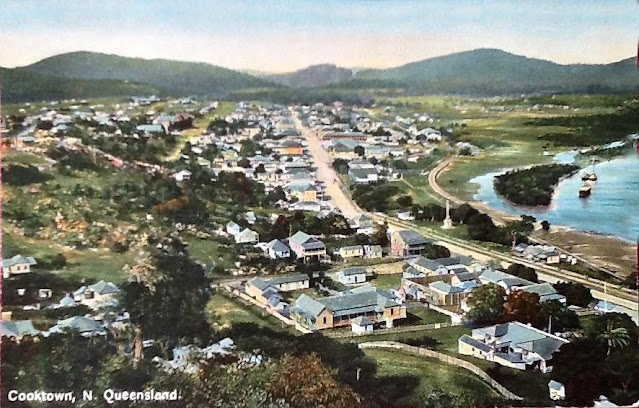 |
| View of Cooktown, QLD - circa 1910, Vintage Queensland |
 |
| Gambling tables at the Cooktown races, ca. 1910, State Library of Queensland |
 |
| Upper Charlotte St, Cooktown, QLD, 1910, Kaye |
 |
| Beche-de-mer Luggers, Cooktown, North Queensland - circa 1910, Kaye |
WW1
 |
| John James MATTHEWS, Cooktown, Queensland, Northern Herald (Cairns, Qld. : 1913 - 1939), Friday 1 June 1917 |
Aboriginal Stockmen
 |
| Aboriginal stocken, Cape York, QLD, Observer (Adelaide, SA : 1905 - 1931), Saturday 11 January 1919 |
 |
| An Aboriginal horseman breaking in a Peninsula brumby .Observer (Adelaide, SA : 1905 - 1931), Saturday 11 January 1919 |
1920s
1930s
 |
| Cooktown men at Barambah Aboriginal Settlement Telegraph (Brisbane, Qld. : 1872 - 1947), Tuesday 19 January 1932 |
 |
| Queenslander (Brisbane, Qld. : 1866 - 1939), Thursday 16 July 1936 |
 |
| Miss. Barbara Hitchins, woman pilot, lands in Cooktown, QLD. Townsville Daily Bulletin (Qld. : 1907 - 1954), Friday 10 June 1938 |
 |
| World's News (Sydney, NSW : 1901 - 1955), Saturday 3 June 1939 |
1940s
 |
| Pilot Officer Gough Whitlam, No 13 Squadron, RAAF, poses with a mug in his hand, at Cooktown, Queensland, 1944. AWM image number P04697.001 |
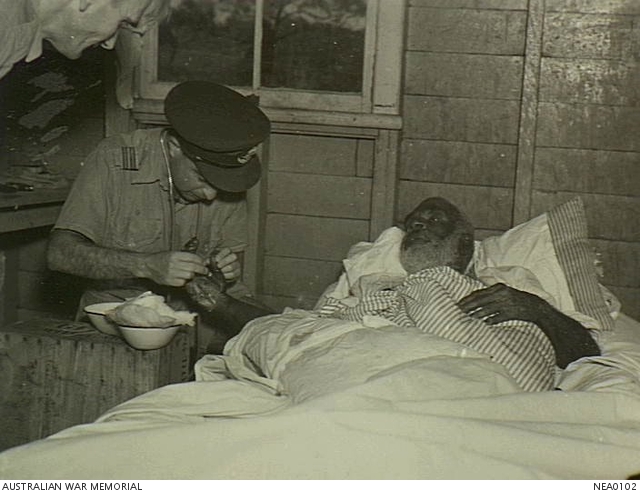 |
| Billy Gibson, an Indigenous Australian of the Gulf region being operated on by a RAAF doctor. Australia: Queensland, North Queensland, Cape York, Cooktown. AWM |
 |
| Herald (Melbourne, Vic. : 1861 - 1954), Saturday 12 October 1946 |
1950s
 |
| Ghost Hotel, Cooktown, QLD, Australian Women's Weekly (1933 - 1982), Wednesday 25 November 1953 |
 |
| Peanut thresher, Cooktown, QLD, Australian Women's Weekly (1933 - 1982), Wednesday 25 November 1953 |
 |
| Charlotte St, Cooktown, Saturday morning, Australian Women's Weekly (1933 - 1982), Wednesday 25 November 1953 |
1960s
 |
| Grassy Hill Lighthouse, Cooktown, c 1966, Queensland State Archives |
1970s
Around Cooktown
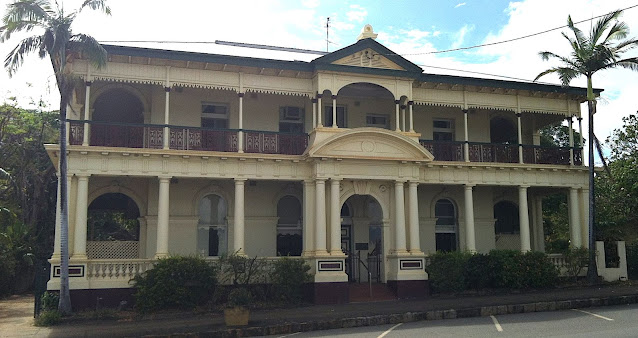 |
| This two-storeyed brick building was completed in 1891, for the Bank of New South Wales, Cooktown, QLD |
 |
| The Cooktown History Centre was built in 1876 as the first Post and Telegraph Office in Cooktown, it is the oldest surviving building in Charlotte Street, Cooktown, QLD |
 |
| Cooktown Post Office, built 1880, Cooktown, Far North Queensland |
 |
| Cooktown Hotel AKA The Top Pub, was established in 1874, Cooktown, QLD |
 |
| The Sovereign Hotel, Cooktown, QLD, was originally constructed in 1874, at the port end of Charlotte Street |
 |
| State of Queensland: Queensland Heritage Register: Cook Shire Council Chambers (1996), Kerry Raymond |
 |
| Cook Shire Hall, was erected in 1907 for the Loyal Captain Cook Lodge of the North Queensland Branch of the Manchester Unity Independent Order of Oddfellows Friendly Society Heritage branch staff |
 |
| The Cooktown Powder Magazine. QLD, was constructed in 1875-76 for the Queensland Department of Ports & Harbours |
 |
| Early Granite Kerbing and Channelling, Cooktown, built from 1884 to 1905 by Thomas Pascoe. |
 |
| Mary Watson's Monument was erected in 1886 by the citizens of Cooktown, QLD, to honour Mrs Mary Watson, who perished, along with her infant son and her Chinese employee Ah Sam |
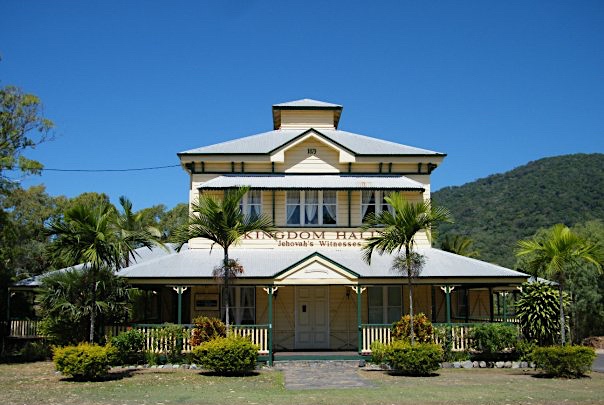 |
| The former Cooktown Hospital was erected in 1879-81, QLD |
 |
| View of Cooktown harbour, QLD |
Things To Do and Places To Go































